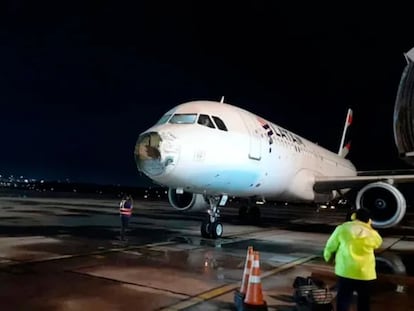Europe says goodbye to ‘airplane mode’: Passengers can talk on the phone while flying
The European Union will serve frequencies of the new 5G network so that travelers can use their cellphones from the air

The first messages that airplane passengers receive before their flight takes off is to turn off their phones or put them in “airplane mode.” But that warning is about to disappear. The European Commission will designate specific frequencies of the new 5G network that will allow cellphones to remain connected while flying.
In practice, the decision will authorize airlines to permit clients to make and receive telephone calls and text messages and use data just as they would on the ground, according to the European Commission. The service will be offered using a piece of special network equipment called a picocell, which connects the plane’s network to the earth through a satellite. “The sky is no longer a limit when it comes to possibilities offered by super-fast, high-capacity connectivity,” Thierry Breton, Commissioner for the Internal market, said in a statement.
Airlines will be able to offer the latest 5G technology on their planes, according to the European Commission’s recent update on in-flight communication, which indicates the designation of certain 5G frequencies for user communication.
Currently, regulations require passenger to turn off their cellphones or activate airplane mode before takeoff and during the entire flight. The practice is a security measure to avoid interference with the plane’s electric and telecommunications systems. Connecting to the internet via wireless devices such as cellphones, tablets and laptops is possible only through an internal Wi-Fi network that the airline company offers, usually as a paid service.
However, the European Commission will now enable a specific frequency band for 5G use, ensuring that it does not interfere with any of the electronic devices on the plane so that the traveler can keep their smartphone on at all times. The network, though, will only work at low altitudes and in favorable weather conditions. In addition, the aircraft commander may order cellphones to be turned off at any time if they deem it appropriate. “5G will enable innovative services for people and growth opportunities for European companies,” Breton said.
The European Commission has also introduced innovations for road transport, where Wi-Fi with 5GHz frequency bands will be able to run in cars, buses and other means of transportation. The measure will take effect on June 30, 2023 “at the latest,” according to the institution.
Safe but not free
Passengers will be able to use their phones on the plane, but that does not mean that the service will be free. Cellphone companies and airlines will likely charge a special rate, since the connection may involve connecting to networks from multiple countries, generating roaming costs. In addition, airlines will have to make a considerable investment in the equipment that allows the connection of terrestrial mobile networks with the plane in flight.
The measure caused controversy when the first plans for its implementation were released. In 2020, the US Federal Communications Commission shot down plans to allow in-flight voice and data services over mobile wireless frequencies, citing strong opposition including from airline pilots and flight attendants for reasons of safety and national security.
Earlier this year, major United States airlines sounded the alarm by sending a joint letter to the main aviation regulatory bodies and the White House. They warned that if operators turned on the 5G network near airports, they could jeopardize the safety of thousands of flights. The frequencies that the new networks use can interfere with the one that planes use to measure their altitude, which can lead to catastrophic accidents. Emirates, Air India, Lufthansa, British Airways and Japan Airlines, among others, announced cancellations and changes of flights to the US for this reason.
In Europe, however, the situation is different: the frequency margins are higher, and there is no danger of interference. European authorities and air safety institutions have been working for over two years to prevent any conflicts.
Tu suscripción se está usando en otro dispositivo
¿Quieres añadir otro usuario a tu suscripción?
Si continúas leyendo en este dispositivo, no se podrá leer en el otro.
FlechaTu suscripción se está usando en otro dispositivo y solo puedes acceder a EL PAÍS desde un dispositivo a la vez.
Si quieres compartir tu cuenta, cambia tu suscripción a la modalidad Premium, así podrás añadir otro usuario. Cada uno accederá con su propia cuenta de email, lo que os permitirá personalizar vuestra experiencia en EL PAÍS.
¿Tienes una suscripción de empresa? Accede aquí para contratar más cuentas.
En el caso de no saber quién está usando tu cuenta, te recomendamos cambiar tu contraseña aquí.
Si decides continuar compartiendo tu cuenta, este mensaje se mostrará en tu dispositivo y en el de la otra persona que está usando tu cuenta de forma indefinida, afectando a tu experiencia de lectura. Puedes consultar aquí los términos y condiciones de la suscripción digital.
More information
Archived In
Últimas noticias
Most viewed
- Reinhard Genzel, Nobel laureate in physics: ‘One-minute videos will never give you the truth’
- Oona Chaplin: ‘I told James Cameron that I was living in a treehouse and starting a permaculture project with a friend’
- Pablo Escobar’s hippos: A serious environmental problem, 40 years on
- Why we lost the habit of sleeping in two segments and how that changed our sense of time
- Chevy Chase, the beloved comedian who was a monster off camera: ‘Not everyone hated him, just the people who’ve worked with him’











































